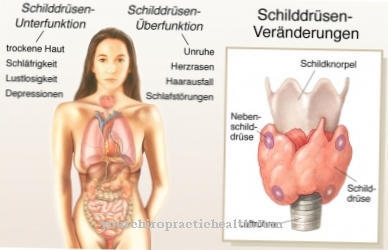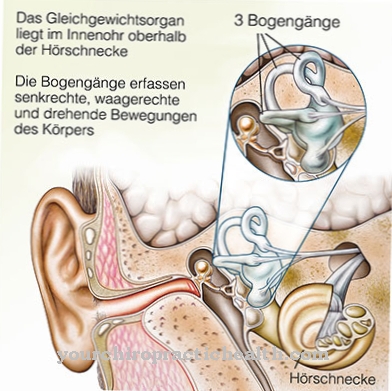As Replication Biology describes the duplication of the genetic information that the human body stores in the form of deoxyribonucleic acid (DNA). Certain enzymes copy the genes, keeping half of the original DNA strand. Biology therefore also speaks of semiconservative replication.
What is replication?
Replication is a biological process that duplicates deoxyribonucleic acid (DNA). DNA is a long chain made up of four types of nucleosides. A nucleoside consists of a sugar (deoxyribose) and a core acid.
In the cell nucleus, the DNA is in the form of chromosomes, which consist of spiraled-on DNA and protein molecules. For replication, the chromosomes uncoil and the DNA double strand smooths out. Then the two complementary DNA strands separate from one another, like the rows of teeth in a zipper. Only then can the actual replication begin.
All living beings multiply their genetic information semiconservatively: one half of the double strand remains, while the second half is newly formed by enzymes. In the first daughter generation, each copy therefore has half of the original DNA of the parent cell, in the second daughter generation it still makes up a quarter of the genes.
As early as 1958, the researchers Meselson and Stahl were able to prove the semi-conservative replication. To do this, they used a biochemical marker that they used to mark the DNA of bacteria. The analyzes confirmed the proportions of original and new DNA, as the scientists had predicted for semi-conservative replication.
Function & task
Most people associate genetics with the inheritance of traits that parents pass on to their children. This is a well-known, but far from the only function of replication. The duplication of DNA in the human body does not only take place to form egg cells and sperm. Every cell division requires a copy of DNA. No cell can function without the genes in the nucleus - genes control the metabolic processes and provide the blueprints for biomolecules.
There are four different nucleic acids in human DNA: adenine, guanine, cytosine and thymine. Every two of them form a so-called base pair; they fit together like two pieces of a puzzle. The sequence of the nucleosides represents the genetic code, which contains all hereditary information of the human body. The combination of the individual nucleosides is comparable to the combination of letters: Although the alphabet only comprises a limited number of letters, an almost infinite number of words can be formed from it.
In theory, cells only need a single strand of DNA to store and pass on information in it. However, DNA has two strands that complement each other. Each piece of information is saved twice. Scientists also refer to the complementary DNA strand as a template. The two chains wind around each other and form the characteristic double helix. Highly specialized enzymes copy the DNA in the cell nucleus. These catalysts are known in biology as DNA polymerases and are made up of protein molecules.
So far, scientists have been able to identify three different DNA polymerases that differ slightly in their functions. The DNA polymerases dock on a DNA strand at a very specific point, which is marked with a primer. A primer is a starter molecule with which the polymerases connect the first nucleoside of the new DNA strand.
The enzymes obtain the energy for their work by splitting off two phosphate residues from the nucleosides, which they use as building blocks. From the primer, the polymerases work from the 5 'end to the 3' end. This happens on both DNA strands of the original genes at the same time. With one of the strands, the enzymes can proceed continuously and supplement the complementary nucleobases one by one. However, since the opposite strand is mirrored and therefore runs in the “wrong” order, replication takes place there as a discontinuous synthesis.
The polymerases also copy the DNA on the template from the primer; however, they can only synthesize fragments because they keep interrupting the process. These so-called Okazaki fragments are later connected by another enzyme - also a DNA polymerase. This DNA polymerase fills in the gaps between the Okazaki fragments by also adding the complementary nucleosides to the template strand. A DNA ligase then migrates over the new double strand and links the lined-up nucleosides to form a solid chain.
Illnesses & ailments
Errors in replication can lead to the development of genetic diseases without there being a specific disease. Occasionally it happens that the DNA polymerase incorporates the wrong nucleoside into the new DNA strand. Biology calls such a mistake a point mutation.
In another type of mutation, insertion, the enzymes add one nucleoside too many during replication. This shifts the grid that divides the nucleosides into groups of three. A group of three forms a gene.
The deletion also shifts the reading frame. In contrast to insertion, the enzymes skip a nucleoside during replication: it appears deleted in the DNA copy. These errors mean that other enzymes cannot read the DNA correctly; the result is incorrectly produced cell building blocks or messenger substances. As a result, metabolic disorders can occur, potentially leading to a wide variety of physical illnesses.
However, mutations do not always have to result in disease. Point mutations, in particular, pose a lower risk if they take place within DNA segments that are of no practical importance for protein synthesis.
Replication errors are particularly critical when the defective DNA ends up in egg or sperm cells. An embryo that arises from this DNA does not have any fault-free DNA besides the mutated DNA: Each new copy of its DNA then also contains the mutation.













.jpg)

.jpg)












